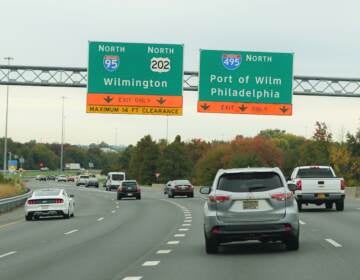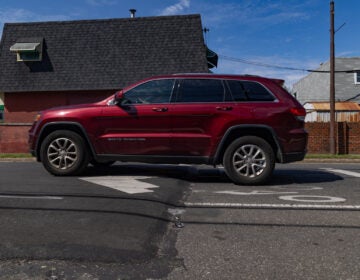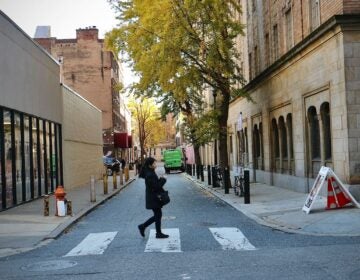Vision Zero panel hears stark stories of traffic-safety horror
Tales of horror and tragedy, of loved ones lost or grievously wounded by automobiles, rolled out in waves before a handful of City Council members.

Cars regularly stop in Philadelphia's bike lanes that aren't "protected" by delineator posts. (Emma Lee/WHYY)
Tales of horror and tragedy, of loved ones lost or grievously wounded by automobiles, rolled out in waves before a handful of City Council members.
At Tuesday’s hearing on Philadelphia’s Vision Zero traffic-safety initiative, crash survivor Regan Kladstrup opened testimony with a searing tale that left committee members wincing.
Last September, Kladstrup said, she was biking to her job at the University of Pennsylvania on Spruce Street, one of Center City’s arterial bike routes. While waiting at a red light, a delivery truck to her left began to turn onto Broad Street across the bike lane — crushing her foot.
“I remember the first sight of my foot: a pulpy mess hanging off the end of my leg,” she said. “It’s an image I wish I could forget. It was turned 90 degrees, every single toe pointed in a different direction, and, worst of all, the skin was hanging off at the end of my foot like a trailing scarf.”
Anne Javsicas described how her husband was run over and killed last year while walking on the sidewalk near 16th Street and John F. Kennedy Boulevard, one of the most dangerous pedestrian intersections in the city. Rebecca Refford detailed how she was cut off and run over by a truck driver, and how her hips and ribs were shattered.
AARP members filled the audience to advocate for Vision Zero, which aims to eliminate traffic deaths by 2030. Also supporting it were the family and loved ones of Pablo Avendano, a cyclist who was hit and killed while riding in a bike lane on Spring Garden Street.
The only committee members who engaged with the advocates were Councilman Kenyatta Johnson and at-large Councilwoman Blondell Reynolds Brown, who called the hearing and often promotes environmental legislation.
Christopher Puchalsky, of the city’s Office of Transportation and Infrastructure Systems, highlighted changes the Kenney administration is implementing, including equipping city trash trucks with four 360-degree cameras to help drivers avoid bikers in their blind spots. (A cyclist in the Spruce Street bike lane was killed by a private trash hauler last year.) Puchalsky also noted the new protected bike lanes on JFK Boulevard and Market Streets and the push for a speed-camera pilot program on Roosevelt Boulevard.
Speakers were generally laudatory of the progress made by Jim Kenney’s administration, especially an additional $6.1 million in operating and capital funds allocated in his budget proposal to Vision Zero.
But in pure numbers, the hearing spotlighted that little has been measurably changed by Vision Zero thus far:
- Roughly 100 people die each year in traffic incidents on Philadelphia’s streets, a number that remains stubbornly persistent. (Seventy-six people died in 2016, a low in recent years, but that number shot back up to 99 deaths last year.)
- About 250 people are severely injured each year.
- Philadelphia’s death rate is more than twice that of New York City’s, where 214 people were killed in traffic incidents last year. In contrast to Philadelphia’s lack of measurable progress, that’s the lowest number since the Big Apple started keeping track of such incidents in 1910. It marks a decline of 28 percent in overall traffic deaths since 2013, the year before Vision Zero began in New York, and a 45 percent decline in pedestrian deaths.
There are several obvious differences between the two cities. New York is devoting $1.6 billion over five years to Vision Zero. Mayor Jim Kenney is proposing $60 million, with much of the projected funding coming from state and federal grants.
The other major difference is City Council’s hyper-local control over where bike lanes are installed, as instituted bylegislation introduced by Councilman William Greenlee in 2012. (No new bike lanes replacing travel or parking lanes were approved between the legislation’s enactment and 2017.) In New York and other major cities, the city council typically does not have veto power over bike lanes.
Bicycle Coalition of Greater Philadelphia’s Sarah Clark Stuart spoke in favor of a recommendation in the Vision Zero Action Plan that calls for the city’s chief traffic engineer to be given the power to change road marking — basically overturning Greenlee’s law.
“The chief traffic engineer should be the final arbiter of safety decisions after robust community outreach,” said Stuart, who is executive director of the Bicycle Coalition.
The council members did not respond to the proposal that they be deprived of veto power over matters of road safety in their districts. After the hearing, neither Reynolds-Brown nor Johnson sounded enthusiastic about the idea, embedded in the early 2017 action plan. Neither had heard of the proposal prior to the hearing.
“It behooves us to have the leadership of experts sometimes, but in concert with district council members because they are on the frontlines,” said Reynolds Brown. “I would defer to district council members and the chief engineer of the city to collectively think that through.”
Johnson said he hears a lot of concerns from immediate neighbors about protected bike lanes because they don’t like the idea of not being able to stop their cars outside their homes to unload groceries.
“We have to make sure there is a check and balance on that process,” said Johnson.
There are fewer than five miles of protected bike lanes in the city, although the mayor has set a goal of 30 miles by 2022.
Advocates spoke repeatedly of the need for protected bike lanes, but argued for them as a traffic-calming device that could save drivers’ and pedestrians’ lives rather than just a boon to cyclists.
“Had the bike lane been clearly marked, I might have been less vulnerable,” Kladstrup told the committee, “and had the lane been protected, I don’t think I would be testifying before you today.”
WHYY is your source for fact-based, in-depth journalism and information. As a nonprofit organization, we rely on financial support from readers like you. Please give today.







